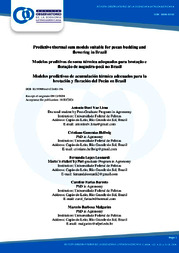Predictive thermal sum models suitable for pecan budding and flowering in Brazil.
Predictive thermal sum models suitable for pecan budding and flowering in Brazil.
Author(s): LIMA, A. D. V.; HELLWIG, C. G.; LEONARDI, F. L.; BARRETO, C. F.; MALGARIM, M. B.; MARTINS, C. R.
Summary: ABSTRACT: This study aimed at evaluating the characterization of budding and flowering phases of pecan cultivars by means of different thermal sum models. Phenological phases of budding and flowering of cultivars Barton, Chickasaw, Desirable, Elliot, Farley, Jackson, Mohawk, Shawnee, Shoshoni and Success were monitored during three harvests from 2018 to 2021. Five phenological phases were established: beginning of budding, emergence of staminate flowers, emergence of pistillate flowers, beginning of pollen release and beginning of stigma receptivity. In addition to the number of days, five thermal sum models were used: DD base 4.5 °C; DD base 10 °C; DD base 15 °C; DD (Anderson) base 4.0 and DD (Anderson) base 10.0. Thermal requirement of the beginning of budding, emergence of staminate flowers, emergence of pistillate flowers, beginning of pollen release and beginning of stigma receptivity by the DD 4.5 model was around 350 DD°, 670 DD°, 590 DD°, 800 DD° and 760 DD°, respectively. The cultivar Chickasaw has lower thermal requirements in the following phases: budding, emergence of pistillate flowers and stigma receptivity when the DD 4.5 model is used. As the result of its thermal requirement, the cultivar Barton is more easily pollinated by cultivars Farley and Barton itself. The DD 4.5 model was the most suitable one for estimating thermal requirements of pecan budding and flowering. RESUMO: Este estudo teve como objetivo avaliar a caracterização das fases de brotação e floração de cultivares de noz-pecã por meio de diferentes modelos de soma térmica. As fases fenológicas de brotação e floração das cultivares Barton, Chickasaw, Desirable, Elliot, Farley, Jackson, Mohawk, Shawnee, Shoshoni e Success foram monitoradas durante três as safras de 2018 a 2021. Para o estudo foram estabelecidas cinco fases fenológicas: início da brotação, emergência das flores estaminadas, emergência das flores pistiladas, início da liberação de pólen e início da receptividade do estigma. Além do número de dias, foram utilizados cinco modelos de soma térmica: GD base 4,5 °C; GD base 10°C; GD base 15°C; GD (Anderson) base 4.0 e GD (Anderson) base 10.0. O modelo GD 4,5. O modelo GD 4,5 foi o mais adequado para estimar as exigências térmicas da brotação e floração da noz-pecã. A exigência térmica do início da brotação, emergência de flores estaminadas, emergência de flores pistiladas, início da liberação de pólen e início da receptividade do estigma pelo modelo GD 4.5 foi em torno de 350 GD°, 670 GD°, 590 GD°, 800 GD° e 760 GD°, respectivamente. A cultivar Chickasaw apresenta menores exigências térmicas nas seguintes fases: brotação, emergência de flores pistiladas e receptividade do estigma quando utilizado o modelo GD 4,5. Como resultado de sua exigência térmica, a cultivar Barton é mais facilmente polinizada pela cultivare Farley e pela própria Barton.
Publication year: 2024
Types of publication: Journal article
Keywords: Carya illinoinensis, Degree Days, Fenologia, Graus-Dias, Nogueira, Noz Peca, Phenology, Receptividade, Receptivity
Observation
Some of Embrapa's publications are published as ePub files. To read them, use or download one of the following free software options to your computer or mobile device. Android: Google Play Books; IOS: iBooks; Windows and Linux: Calibre.
Access other publications
Access the Agricultural Research Database (BDPA) to consult Embrapa's full library collection and records.
Visit Embrapa Bookstore to purchase books and other publications sold by Embrapa.

